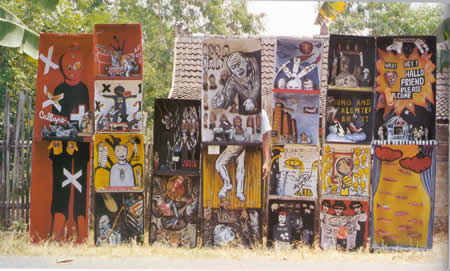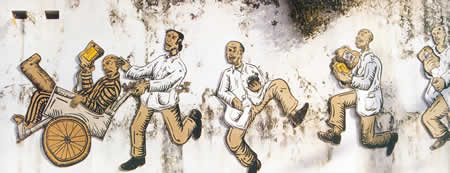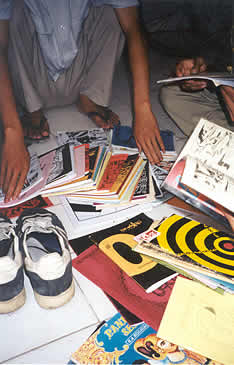|
Nattering with members from the former Apotik
Komik
Apotik Komik
was an artists’ collective based out of Yogyakarta in the nineties,
who created work in response to the political and social conditions of
Indonesia during that decade. Apotik Komik was: Arie Dyanto, Samuel Indratma,
Bambang Toko, and Popok Tri Wahyudi. Today the artists still create work
from the same socially/politically-driven approach, however, each works
individually.
 |
Nattering with Apotik Komik
Photo Credit: Megan Wilson |
|
Megan Wilson What
exactly was Apotik Komik?
Apotik Komik Apotik Komik was a visual
community living and working in Yogya [in Indonesia]. Collectively we
made work in public spaces – alternative spaces outside of the gallery
that we found – empty walls, billboards.
MW Did you guys get permission to
use the spaces that you worked on?
AK Not always, and we did get in trouble
with the government at times, which led to the design of "official" uniforms
that we’d wear when we made our public work.
MW Sort of like guerrilla actions?
AK Yes, exactly, these were guerrilla
actions.
MW What kind of materials would you
use when you did your work, and did you ever use spaces that already existed
and alter them – like billboards?
[The group exchange sideways glances and laughs.]
AK Yes, much of our work —
then and now — is about this type of play, working with irony and
subversion instead of trying to hit people over the head with a message.
Our work is political and comments on social conditions here, but it’s
not meant to be a direct political action or protest. We want it to be
subtle and humorous – poking fun at tradition. We often use plywood
or cardboard and house paints because the materials that artists normally
use, like – canvas and oil or acrylic paints, – are very expensive
here. And we like the idea of using these alternative materials and the
idea that they’re temporary until destroyed. We also make comic books,
… individually and collectively.
 |
| Under Estimate, cardboard and
paint, 1999, 300 x 500 x 40 cm |
|
MW When did
you guys start working together – and how did Apotik Komik start?
AK It started in 1992, however we
began to get a lot more visibility in 1997 with a show that Samuel (Samuel
Indratma is the fourth member of Apotik, who was unable to be at the interview)
organized at his house called Apotik Komik. It took place on the
day of the general election and was risky because the government had associated
our group with the PRD (Democratic People’s Party), which is outlawed
here and they were keeping a watch on us. It was a group show and used
the wall of Samuel’s house with the theme of "flying."
MW So what happened?
AK It was very successful and got
a lot of attention from the art community and from the press (private
television companies – (RCTI, SCTV and Anteve, the National broadcast
TVRI) – and several printed media (– BERNAS, Kedaulatan
Rakyat dailies and Panji Masyarakat magazine.).
MW That’s great that you had
such support.
 |
| Sakit berlanjut/ Ongoing illness
, Wall installation, cardboard and ink, 1999 detail |
|
MW So where
did the comic book influence come from?
AK We all grew up looking at DC and
Marvel comics, which were an important influence, but then when we saw
RAW, that was it. We became much more interested in that form of
nontraditional comic book, but using the form to comment on the local
community.
MW Are comic books popular in Indonesia?
AK Yes, both the traditional Indonesian
comics and the American ones, but there is a difference between here and
Bandung [Bandung is another city also recognized as an artistic and cultural
center on the island of Java]. Bandung is more interested in the traditional
comics and action figures, where as Yogya has a more alternative approach
to this form of art – more the RAW approach.
 |
Comic books
Photo Credit: Megan Wilson |
|
MW The do-it-yourself
approach?
AK Yes, do-it-yourself
and print it and publish it yourself.
MW So I’ve heard this comparison
between Yogya and Bandung before – what’s up with that?
AK The art collectives from Bandung,
like Taring Padi, are more like hippies and very directly political. They’re
more like Rage Against the Machine, and we’re more like the Red Hot
Chili Peppers. We like to drink coffee, tea, and beer, to smoke cigarettes,
and to natter.
|



